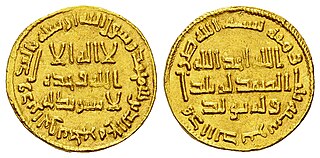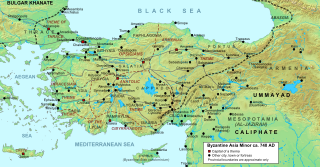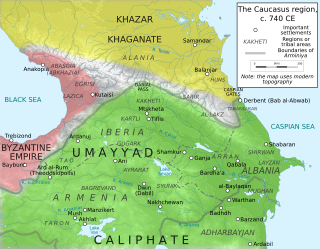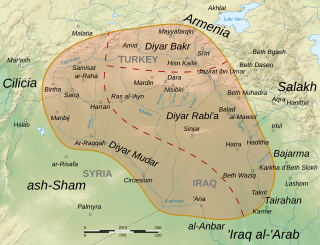The 740s decade ran from January 1, 740, to December 31, 749.

Yazid ibn Abd al-Malik ibn Marwan, commonly known as Yazid II, was the ninth Umayyad caliph, ruling from 720 until his death in 724. Although he lacked administrative or military experience, he derived prestige from his lineage, being a descendant of both ruling branches of the Umayyad dynasty, the Sufyanids who founded the Umayyad Caliphate in 661 and the Marwanids who succeeded them in 684. He was designated by his half-brother, Caliph Sulayman ibn Abd al-Malik, as second-in-line to the succession after their cousin Umar, as a compromise with the sons of Abd al-Malik.
Hisham ibn Abd al-Malik ibn Marwan was the tenth Umayyad caliph, ruling from 724 until his death in 743.

The Battle of Akroinon was fought at Akroinon or Akroinos in Phrygia, on the western edge of the Anatolian plateau, in 740 between an Umayyad Arab army and the Byzantine forces. The Arabs had been conducting regular raids into Anatolia for the past century, and the 740 expedition was the largest in recent decades, consisting of three separate divisions. One division, 20,000 strong under Abdallah al-Battal and al-Malik ibn Shu'aib, was confronted at Akroinon by the Byzantines under the command of Emperor Leo III the Isaurian and his son, the future Constantine V. The battle resulted in a decisive Byzantine victory. Coupled with the Umayyad Caliphate's troubles on other fronts and the internal instability before and after the Abbasid Revolt, this put an end to major Arab incursions into Anatolia for three decades.
ʿAbd al-Raḥmān ibn Ḥabīb al-Fihrī was an Arab noble of the Fihrid family, and ruler of Ifriqiya from 745 through 755 AD.

The Berber Revolt or the Kharijite Revolt of 740–743 AD took place during the reign of the Umayyad Caliph Hisham ibn Abd al-Malik and marked the first successful secession from the Arab caliphate. Fired up by Kharijite puritan preachers, the Berber revolt against their Umayyad Arab rulers began in Tangier in 740, and was led initially by Maysara al-Matghari. The revolt soon spread through the rest of the Maghreb and across the straits to al-Andalus.

Arminiya, also known as the Ostikanate of Arminiya or the Emirate of Armenia, was a political and geographic designation given by the Muslim Arabs to the lands of Greater Armenia, Caucasian Iberia, and Caucasian Albania, following their conquest of these regions in the 7th century. Though the caliphs initially permitted an Armenian prince to represent the province of Arminiya in exchange for tribute and the Armenians' loyalty during times of war, Caliph Abd al-Malik ibn Marwan introduced direct Arab rule of the region, headed by an ostikan with his capital in Dvin. According to the historian Stephen H. Rapp in the third edition of the Encyclopaedia of Islam:
Early Arabs followed Sāsānian, Parthian Arsacid, and ultimately Achaemenid practice by organising most of southern Caucasia into a large regional zone called Armīniya.
The Battle of the Nobles was an important confrontation in the Berber Revolt in c. 740 AD. It resulted in a major Berber victory over the Arabs in banks of the Chelif River, near Chlef (Algeria). During the battle, numerous Arab aristocrats were slaughtered, which led to the conflict being called the "Battle of the Nobles". Zenata Berber chieftain Khalid ibn Hamid al-Zanati led the revolting Berber soldiers.
Habib ibn Abi Ubayda al-Fihri was an Arab military commander of the illustrious Fihrid family who played an important role in the early history of Ifriqiya (Tunisia) and al-Andalus (Spain).
The Fihrids, also known as Banu Fihr, were an Arab family and clan, prominent in North Africa and Al-Andalus in the 8th century.
The Battle of Bagdoura or Battle of Baqdura was a decisive confrontation in the Berber Revolt in late 741 CE. It was a follow-up to the Battle of the Nobles the previous year, and resulted in a major Berber victory over the Arabs by the Sebou River. The battle would permanently break the hold of the Umayyad Caliphate over the far western Maghreb, and the resulting retreat of elite Syrian forces into Spain would have implications for the stability of al-Andalus.
Ubayd Allah ibn al-Habhab al-Saluli was an important Umayyad official in Egypt from 724 to 734, and subsequently Umayyad governor of Kairouan, Ifriqiya from 734 to 741. It was under his rule that the Great Berber Revolt broke out in the Maghreb and al-Andalus.
Maysar al-Matghari was a Berber rebel leader and original architect of the Great Berber Revolt that erupted in 739-743 against the Umayyad Muslim empire. However, he was deposed by the rebels, replaced with another Berber leader, and died or possibly was executed by them in 740. The Berber Revolt succeeded 3 years after his death in defeating the Umayyad armies.
Khalid ibn Abi Habib al-Fihri was an Arab military commander in North Africa during the Berber Revolt, who led the Arab army that was defeated at the Battle of the Nobles in late 740. The chronicles are oddly ambiguous on the biographical details of Khalid ibn Abi Habib. It is acknowledged that he was a member of the illustrious Fihrid family, descendants of the great Arab conqueror Uqba ibn Nafi al-Fihri. The patronymic structure suggests Khalid is the son of the father of Habib, which would imply that it is likely Khalid was the brother of Habib ibn Abi Ubayda al-Fihri, the principal military commander of Ifriqiya. But this is not confirmed.

The siege of Nicaea of 727 was an unsuccessful attempt by the Umayyad Caliphate to capture the Byzantine city of Nicaea, the capital of the Opsician Theme. Ever since its failure to capture the Byzantine Empire's capital, Constantinople, in 717–718, the Caliphate had launched a series of raids into Byzantine Asia Minor. In 727, the Arab army, led by one of the Caliph's sons, penetrated deep into Asia Minor, sacked two Byzantine fortresses and in late July arrived before Nicaea. Despite constant attacks for 40 days, the city held firm and the Arabs withdrew and returned to the Caliphate. The successful repulsion of the attack was a major boost for Byzantine emperor Leo III the Isaurian's recently initiated campaign to abolish the veneration of icons in the Empire; Leo claimed it as evidence of divine favour for his policy. The siege of Nicaea marks also the high point of the Umayyad raids, as new threats and defeats on their far-flung frontiers decreased Umayyad strength elsewhere, while Byzantine power strengthened afterwards.
Mu'awiya ibn Hisham (Arabic: معاوية بن هشام, romanized: Muʿāwiya ibn Hishām; was an Arab general and prince, the son of the Umayyad Caliph Hisham ibn Abd al-Malik, who distinguished himself in the Arab–Byzantine Wars. His son, Abd al-Rahman ibn Mu'awiya, was the founder of the Emirate of Córdoba and the Umayyad line of al-Andalus.
Sulaymān ibn Hishām ibn ʿAbd al-Malik was an Arab general, the son of the Umayyad Caliph Hisham ibn Abd al-Malik. He is known for his participation in the expeditions against the Byzantine Empire as well as his prominent role in the civil wars that occurred during the last years of the Umayyad Caliphate. Defeated by Marwan II, he fled to India, where he died.

Al-Jazira, also known as Jazirat Aqur or Iqlim Aqur, was a province of the Rashidun, Umayyad and Abbasid Caliphates, spanning at minimum most of Upper Mesopotamia, divided between the districts of Diyar Bakr, Diyar Rabi'a and Diyar Mudar, and at times including Mosul, Arminiya and Adharbayjan as sub-provinces. Following its conquest by the Muslim Arabs in 639/40, it became an administrative unit attached to the larger district of Jund Hims. It was separated from Hims during the reigns of caliphs Mu'awiya I or Yazid I and came under the jurisdiction of Jund Qinnasrin. It was made its own province in 692 by Caliph Abd al-Malik. After 702, it frequently came to span the key districts of Arminiya and Adharbayjan along the Caliphate's northern frontier, making it a super-province. The predominance of Arabs from the Qays/Mudar and Rabi'a groups made it a major recruitment pool of tribesmen for the Umayyad armies and the troops of the Jazira played a key military role under the Umayyad caliphs in the 8th century, peaking under the last Umayyad caliph, Marwan II, until the toppling of the Umayyads by the Abbasids in 750.
Al-Ghamr ibn Yazid ibn Abd al-Malik was an Umayyad prince and commander. He led the last Umayyad campaign against the Byzantine Empire in 743.
Umayyad rule in North Africa or Umayyad Ifriqiya was a province of the Umayyad Caliphate (661–750) during the historical period in which it ruled the Maghreb region of North Africa, from its conquest of the Maghreb starting in 661 to the Kharijite Berber Revolt ending in 743, which led to the end of its rule in the western and central Maghreb. Following this period, the Umayyads retained their rule over Ifriqiya while the rest of the Maghreb fell to successive Islamic dynasties of Arab, Berber and Persian descent.






